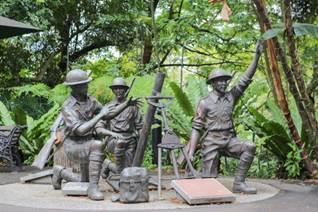Archives and Heritage in Singapore: The Development of ‘Reflections at Bukit Chandu’, a World War II Interpretive Centre
May 16, 2017

How do archives shape our understanding of history and heritage?
International Museum Day (IMD) is celebrated annually on 18 May to acknowledge the importance of museums in facilitating cultural exchange and promoting mutual understanding between peoples and societies. IMD is especially relevant to Singapore given the large number of museums it hosts — each with a unique approach to interpreting history and heritage. On 15 February 2002, the National Archives of Singapore (NAS) redeveloped a colonial bungalow into Reflections at Bukit Chandu, a World War II interpretive centre. The centre commemorates the Malay Regiment’s officers and soldiers who made a heroic stand against Japanese forces in one of the last battles before the fall of Singapore 60 years ago. Dr Donna Brunero (Senior Lecturer, Department of History), in Archives and Heritage in Singapore: The Development of ‘Reflections at Bukit Chandu’, a World War II Interpretive Centre (International J. of Heritage Studies, 2006) examines the centre’s significance to Singapore’s rising heritage movement, which recently witnessed a desire for a more ‘historically in-touch Singapore’ that not only values the past but also acknowledges history’s relevance to the present day. The centre relies heavily on archives, including historical photographs and documents, to localise history and develop the narrative of the Malay Regiment’s sacrifice and bravery. Simultaneously, features such as the Well of Reflections diorama and the Hall of Memories exhibit symbolise NAS’s emotive and empathetic approach to artefacts, creating new possibilities for direct engagement with visitors to reflect on ideas of ‘rootedness’ and identification with Singapore. The interpretive centre hence strategically connects Singapore’s colonial past and post-colonial present. Furthermore, it highlights Singapore’s shifting focus from the migrant experience and struggle for survival, towards the celebration of present-day nationhood and shared connections to the homeland.
To learn more, click here.
